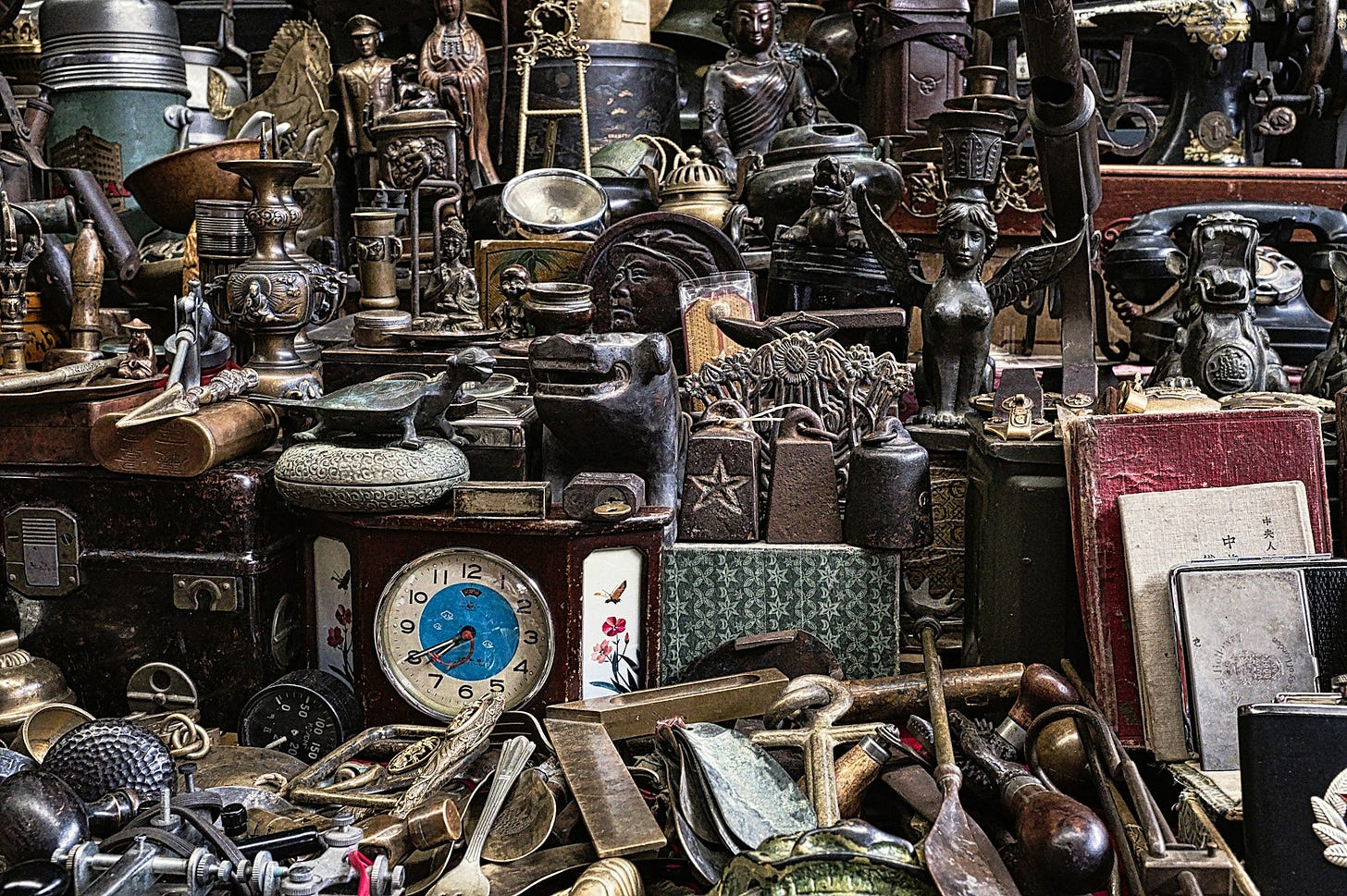This week we are diving into cultural objects like art or our clothes, and their meaning for the cultural capital of a family. For this edition, my friend Wolfgang Pichler has kindly offered to write about the topic. Wolfgang is a retired art expert, who has now turned to writing, check out his substack.
Object Lessons - Or the importance of objects as indicators of Cultural Capital

Everyone knows the feeling one gets when you find some treasured item from your past and how these can hold so many seemingly long forgotten memories, who all come to the surface at once because of that otherwise inconsequential object. And just as this item is able to stir your feelings all objects are not only physical things but symbols and signs telling us not only about themselves but most of all about the people connected with them. The following article will try to shed some light on how those objects are talking to us and on a more practical note what they are telling others about you.
There is a reason why we talk about something being “objectively” this or that , because we somehow know that objects can’t lie. While this is not entirely true it still is far harder to lie trough objects than trough words - as objects have the irritating habit of not changing at your every wish, but have to be removed and replaced - and even that is sometimes not possible. So we have - as a species capable of telling stories – learned that those might be not entirely true and sometimes even are used to mislead us. Which leaves us with no other option as to try to get some sort of other indication of what it is we are being told. As this is an article trying to discuss the importance of objects as indicators for a variety of things but ultimately as signifying cultural capital in our society I will just mention that all sorts of applied psychology are of course available but not the topic of this essay.
The other option is to try to read, and I stress that this is usually done entirely subconsciously, the objects we are presented with – such as the clothes and the various devices of our modern life, like cars and watches etc. Whilst most people have some sort of idea that if such an object is known to be very expensive it will indicate the person handling it being wealthy – and I am deliberately not talking of owning it because this is not what we see but merely what we assume. For example driving a sportscar is mostly seen as an indicator of wealth , but it is rarely known how seemingly unimportant small objects are shaping our view of the world.
I would like to give you an example that strikes me as being able to illustrate what I mean. In the UK there is a long tradition of men wearing a signet ring on the pinky finger of the left hand thus indicating the wearer of such an item to be a member of the upper or upper middle class which has by and large survived to the present day. While most people, even of the highest social status, nowadays do not wear formal clothes, many wear their signet ring on a daily basis even when in the gym or on the school run or on holidays in bermudas and sandals. Most of us would not be able to tell what it is about that person that we perceive as “class” while actually we have trained our brain to associate wearing a gold signet ring on the pinky finger with a certain social status. Coming back to the importance of such seemingly trivial matters I would like to suggest, that any of you would in doubt trust the person with a shabby or very understated attire who wears such a ring more than someone in a Bentley with fancy clothes but without the ring.
This is the case because we are not merely trying to establish the wealth and current social status of that individual by observing these indicators, but we are trying to rely on a set of rules and values that those objects stand for. In short we are trying to decipher if someone had an upbringing that thought him or her certain values. The very same goes for other objects such as the furniture in the background of a portrait on social media or what can be seen on a video call, these things together with a certain postcode and your name and your clothes will determine how you are perceived by others. All of these will eventually, once you get to know a person better, become almost irrelevant - but you most likely won’t get to know that person any better if in the first place you do not “like” what you are seeing. One informal picture of someone in a private setting that can be processed in a split second will tell you subconsciously more than a lengthy CV.
So how do these visible objects carry such a wealth of information - and on the practical side of things - how are which objects perceived by whom? The first question is far to complicated to answer in such a short piece, and to be honest, I doubt that we even scratched the surface of how it all works. In short - they have meaning because of our shared cultural values and experiences. They act as triggers for all sorts of memories who will be linked to - lets say a certain shape of a table. Some are personal, like your grandmother had such a table in her study, but others will be our cultural heritage telling you that such a shape is associated with stately homes and powerful people and so the list goes on in probably hundreds of layers of all sorts. The important thing here is that you will “only” have a feeling about that table or desk telling you that who ever has such a piece of furniture in his home will be somehow trustworthy and important. Depending on your personal experience and upbringing the same object may cause the exact opposite reaction as it is to you a symbol of oppression and deceit, but never the less the key information that it is most likely to be found within a certain section of society stays the same.
The tricky part is to describe the Cultural Capital that is linked to certain things and how they can be used deliberately to give a particular impression. This is what is done by actors all the time, and in my experience can be used to enhance ones impression upon others when applied carefully and in line with your character. And this is the key part, because as soon as you have the slightest dissonance between what you feel and what you are signalling trough your appearance it will have the opposite effect and you will be perceived as strange, weird or simply empty and shallow.
Cultural Capital as Pierre Bourdieu described it is one of the four forms of capital every individual possesses. The other three being: Economic Capital ( eg. money, assets, property ), Social Capital ( basically all your friends and family as well as acquaintances - the connections you have ), and Symbolic Capital which describes all forms of honours and titles or the formal structure of a society.
These are all interchangeable and therefore your internalised Cultural Capital for example in the form of knowing how to dress for a certain occasion can be interchanged into Economic Capital because you are welcome at a certain club and able to meet potential investors for your start up there. The same goes for Economic Capital being interchanged into Symbolic Capital via sending your kids to an expansive school which gives them the chance for a prestigious degree.
While this is a crude and not at all scientific way to explain the concept of Cultural Capital which I am adopting in order to not have to write a lengthy paper and bore you to death I would still like to state that there are three states of Cultural Capital: The Embodied State where your being “cultured” and “educated” as well as all the things like “etiquette” and the way you talk are found. The Institutionalized State where your degrees and certificates are found and The Objectified State where all pieces of art and antiques as well as jewellery and clothes are found.
These objects signify specific things and not merely that you are a person of taste and education – tough this in itself is a valuable asset to have – but are indicators of certain aspects of your personality. They are like an advertisement for who you are and therefore should be considered carefully. This is why all kinds of art and everyday paraphernalia matter more than even those who love to handle collect and use them start to imagine - they are to those who know what they mean ( be it consciously or not ) a key to your personality and your intentions.






